window Abarth 500 2012 Owner handbook (in English)
[x] Cancel search | Manufacturer: ABARTH, Model Year: 2012, Model line: 500, Model: Abarth 500 2012Pages: 170, PDF Size: 3.5 MB
Page 37 of 170

36
SAFETY
DEVICES
CORRECT USE
OF THE
CAR
WARNING
LIGHTS AND
MESSAGES
IN AN
EMERGENCY
CAR
MAINTENANCE
TECHNICAL
SPECIFICATIONS
INDEX
YOUR CAR
Ceiling light timing (central
position of the lens)
Three different switch on modes are fore-
seen:
❒when opening one door, a three minute
timing is set;
❒when removing the key from the igni-
tion switch within two minutes from
engine switch off, a 10 second timing
is set;
❒when doors are unlocked (either with
remote control or with key on driver
side door), a 10 second timing is set.
Three modes are foreseen for switch off:
❒when closing all doors, a three minute
timing is set; The timing is disabled if the
key is moved to MAR;
❒when doors are locked (either with re-
mote control or with key on driver side
door), the ceiling light turns off.
❒the internal lights turn off after 15 min-
utes to avoid battery drain
BOOT LIGHT
The lamp comes on automatically when the
luggage compartment is opened and goes
out when it is closed.
CEILING LIGHTS
FRONT CEILING LIGHT
The lens can be set to three positions:
❒right side pressed: light always on
❒left side pressed: light always off
❒central position (neutral): the light turns
on and off when the doors are opened
or closed.
IMPORTANT Before getting out of the
car, make sure the switch is on the cen-
tral position: ensure that lights are off with
doors closed in order to avoid draining
the battery.
On same versions, light switch on and off
occur only when the front driver side door
is opened or closed.
When the doors are unlocked using the re-
mote control, a 10 second timing turns on.
When the doors are locked using the re-
mote control, the ceiling light turns off. REAR WINDOW WIPER/
REAR WINDOW WASHER
The device can work only when the igni-
tion key is on MAR.
Turn the knurled ring to
'to operate
the rear window wiper.
With the windscreen wiper active, rotate
the knurled ring to
'to activate the rear
window wiper which, in this case, oper-
ates (in the different positions) in synch
with the windscreen wiper, yet with half
its frequency. With windscreen wiper ac-
tive, engaging reverse gear, the rear win-
dow wiper automatically turns on in slow
continuous mode.
It stops when the reverse gear is disen-
gaged.
“Smart washing” function
Pushing the stalk towards the dashboard
(unstable position) will activate the rear
window washer.
Keep the stalk pushed to activate with a
single movement the rear window wash-
er jet and the rear window wiper; the lat-
ter automatically turns on if you keep the
stalk pushed for over half a second.
The rear window wiper stops operating
a few strokes after releasing the stalk; a
further “cleaning stroke”, after a few sec-
onds, completes the wiping operation.
Do not use the rear window
wiper to remove layers of
snow or ice from the rear win-
dow. In such conditions, the
rear window wiper may be subjected to
excessive stress and the motor protec-
tion which prevents operation for a few
seconds may trip. If the issue persists,
contact the Abarth Dealership.
Page 46 of 170
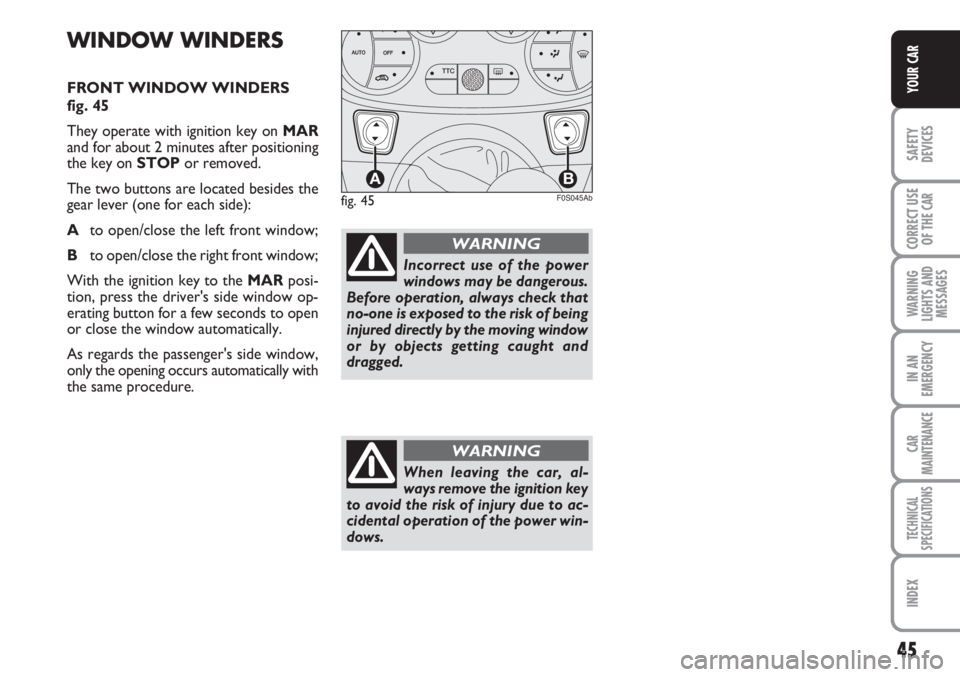
45
SAFETY
DEVICES
CORRECT USE
OF THE
CAR
WARNING
LIGHTS AND
MESSAGES
IN AN
EMERGENCY
CAR
MAINTENANCE
TECHNICAL
SPECIFICATIONS
INDEX
YOUR CAR
WINDOW WINDERS
FRONT WINDOW WINDERS
fig. 45
They operate with ignition key on MAR
and for about 2 minutes after positioning
the key on STOPor removed.
The two buttons are located besides the
gear lever (one for each side):
Ato open/close the left front window;
Bto open/close the right front window;
With the ignition key to the MARposi-
tion, press the driver's side window op-
erating button for a few seconds to open
or close the window automatically.
As regards the passenger's side window,
only the opening occurs automatically with
the same procedure.
fig. 45
TTC
AB
F0S045Ab
Incorrect use of the power
windows may be dangerous.
Before operation, always check that
no-one is exposed to the risk of being
injured directly by the moving window
or by objects getting caught and
dragged.
WARNING
When leaving the car, al-
ways remove the ignition key
to avoid the risk of injury due to ac-
cidental operation of the power win-
dows.
WARNING
Page 64 of 170
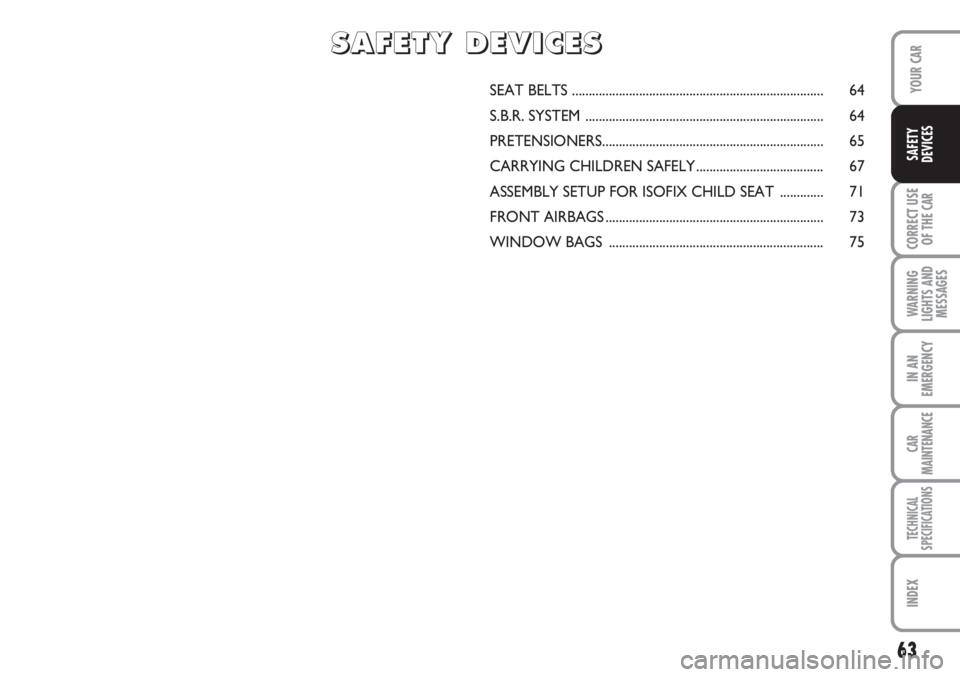
63
CORRECT USE
OF THE
CAR
WARNING
LIGHTS AND
MESSAGES
IN AN
EMERGENCY
CAR
MAINTENANCE
TECHNICAL
SPECIFICATIONS
INDEX
YOUR CAR
SAFETY
DEVICES
SEAT BELTS ........................................................................... 64
S.B.R. SYSTEM ....................................................................... 64
PRETENSIONERS.................................................................. 65
CARRYING CHILDREN SAFELY...................................... 67
ASSEMBLY SETUP FOR ISOFIX CHILD SEAT ............. 71
FRONT AIRBAGS................................................................. 73
WINDOW BAGS................................................................ 75
S S
A A
F F
E E
T T
Y Y
D D
E E
V V
I I
C C
E E
S S
Page 74 of 170

73
CORRECT USE
OF THE
CAR
WARNING
LIGHTS AND
MESSAGES
IN AN
EMERGENCY
CAR
MAINTENANCE
TECHNICAL
SPECIFICATIONS
INDEX
YOUR CAR
SAFETY
DEVICES
AIRBAGS
The car is provided with front air bags for
the driver and the passenger, driver’s
knees air bag and side bags - window bags.
FRONT AIRBAGS
The front airbags (driver’s, passenger’s,
driver’s knees air bags) have been designed
to protect the occupants in the event of
head-on crashes of medium-high severity,
by placing the cushion between the occu-
pant and the steering wheel or dashboard.
Front air bags are designed to protect
car’s occupants in front crashes and there-
fore non-activation in other types of col-
lisions (side collisions, rear shunts, roll-
overs, etc.) is not a system malfunction.
An electronic control unit will make the
bag inflate in the event of a frontal crash.
The bag will inflate instantaneously placing
itself between the front occupant’s body
and the structures which could cause in-
jury. It will deflate immediately afterwards.
The front airbags (driver’s, passenger’s,
driver’s knees air bags) are not a replace-
ment of but complementary to the belts,
which you are recommended to always
wear, as specified by law in Europe and
most non-European countries.In the event of a collision, a person not
wearing a seat belt may be thrown forward
and come into contact with the bag before
it has fully opened. The protection offered
by the cushion is reduced in such a case.
Front air bags may not be activated in the
following situations:
❒in collisions against highly deformable
objects not affecting the car front sur-
face (e.g. bumper collision against guard
rail, etc.);
❒car penetration under other vehicles or
protective barriers (e.g. trucks or guard
rails);
they could not provide any additional pro-
tection compared with seat belts, so their
activation would be improper. No de-
ployment in such cases is consequently not
the sign of a fault.
Do not apply stickers or oth-
er objects on the steering
wheel, on the dashboard in the pas-
senger side airbag area, on side up-
holstery on roof and on the seats. Do
not place objects (e.g. cell phones) on
the passenger side dashboard because
these could interfere with the correct
opening of the airbag and cause se-
vere injury to occupants.
WARNING
The front airbags (driver’s, passenger’s,
driver’s knees air bags) are designed and
calibrated to protect the front seat pas-
sengers who wear the safety belts.
Their volume at the moment of maximum
inflation fills most space between the
steering wheel and the driver, between
the lower post guard and the knees on
passenger side and between the dash-
board and the passenger.
The airbags are not deployed in the event
of front collisions of low severity (for
which the withholding action of the seat
belts is sufficient). Safety belts must always
be used. In the event of frontal crash they
ensure the correct positioning of the oc-
cupant.
Page 76 of 170

75
CORRECT USE
OF THE
CAR
WARNING
LIGHTS AND
MESSAGES
IN AN
EMERGENCY
CAR
MAINTENANCE
TECHNICAL
SPECIFICATIONS
INDEX
YOUR CAR
SAFETY
DEVICES
DRIVER’S KNEES AIR BAG fig. 14
It consists of an instant-inflating cushion
housed into a special compartment pro-
vided for the purpose under the lower
post guard at driver’s knees level, designed
to give further protection in the event of
frontal crash.MANUAL DEACTIVATION OF
PASSENGER’S FRONT AIR BAG
AND SIDE BAG
Should it be absolutely necessary to car-
ry a child on the front seat, the passenger’s
front air bag and the Side Bag can be de-
activated.
The instrument panel warning light
“will
stay on glowing steadily until reactivating
the passenger’s front air bag and the Side
Bag.
WARNING To deactivate the passenger’s
front air bag and the Side Bag, refer to
paragraphs “Digital display” and “Multi-
functional display” in section “Your car”.
SIDE BAGS -
WINDOW BAGS
SIDE BAG fig. 15
It consists of an instant-inflating cushion
housed in the front seat backrest. It pro-
tects the chest and the hips of the pas-
sengers in the event of side crash of medi-
um-high severity.
fig. 14F0S073Ab
Page 77 of 170
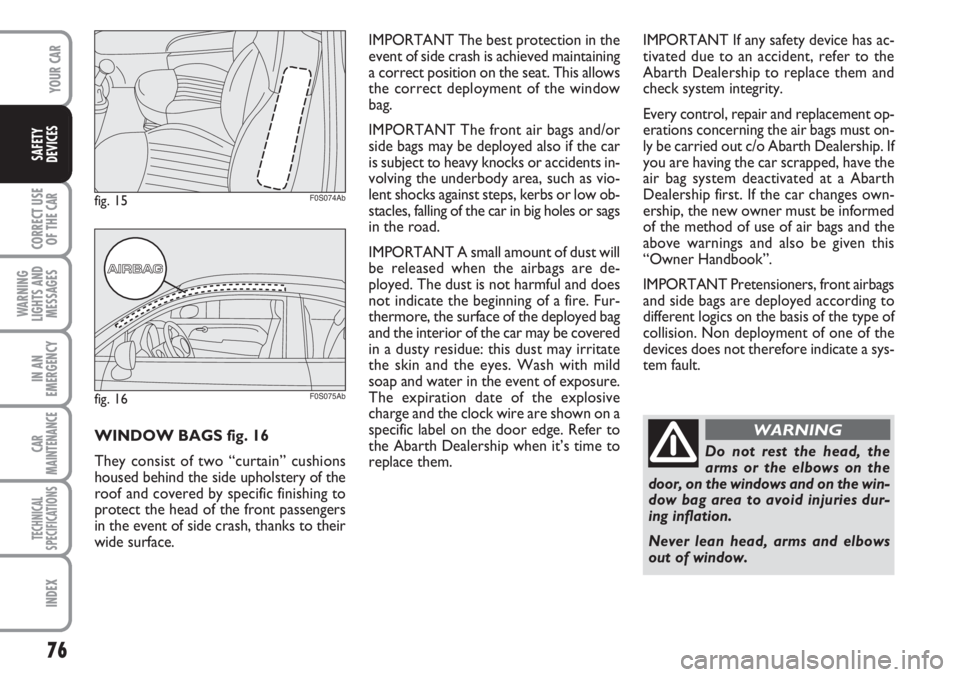
76
CORRECT USE
OF THE
CAR
WARNING
LIGHTS AND
MESSAGES
IN AN
EMERGENCY
CAR
MAINTENANCE
TECHNICAL
SPECIFICATIONS
INDEX
YOUR CAR
SAFETY
DEVICES
Do not rest the head, the
arms or the elbows on the
door, on the windows and on the win-
dow bag area to avoid injuries dur-
ing inflation.
Never lean head, arms and elbows
out of window.
WARNINGWINDOW BAGS fig. 16
They consist of two “curtain” cushions
housed behind the side upholstery of the
roof and covered by specific finishing to
protect the head of the front passengers
in the event of side crash, thanks to their
wide surface.IMPORTANT The best protection in the
event of side crash is achieved maintaining
a correct position on the seat. This allows
the correct deployment of the window
bag.
IMPORTANT The front air bags and/or
side bags may be deployed also if the car
is subject to heavy knocks or accidents in-
volving the underbody area, such as vio-
lent shocks against steps, kerbs or low ob-
stacles, falling of the car in big holes or sags
in the road.
IMPORTANT A small amount of dust will
be released when the airbags are de-
ployed. The dust is not harmful and does
not indicate the beginning of a fire. Fur-
thermore, the surface of the deployed bag
and the interior of the car may be covered
in a dusty residue: this dust may irritate
the skin and the eyes. Wash with mild
soap and water in the event of exposure.
The expiration date of the explosive
charge and the clock wire are shown on a
specific label on the door edge. Refer to
the Abarth Dealership when it’s time to
replace them.
fig. 16F0S075Ab
fig. 15F0S074Ab
IMPORTANT If any safety device has ac-
tivated due to an accident, refer to the
Abarth Dealership to replace them and
check system integrity.
Every control, repair and replacement op-
erations concerning the air bags must on-
ly be carried out c/o Abarth Dealership. If
you are having the car scrapped, have the
air bag system deactivated at a Abarth
Dealership first. If the car changes own-
ership, the new owner must be informed
of the method of use of air bags and the
above warnings and also be given this
“Owner Handbook”.
IMPORTANT Pretensioners, front airbags
and side bags are deployed according to
different logics on the basis of the type of
collision. Non deployment of one of the
devices does not therefore indicate a sys-
tem fault.
Page 84 of 170
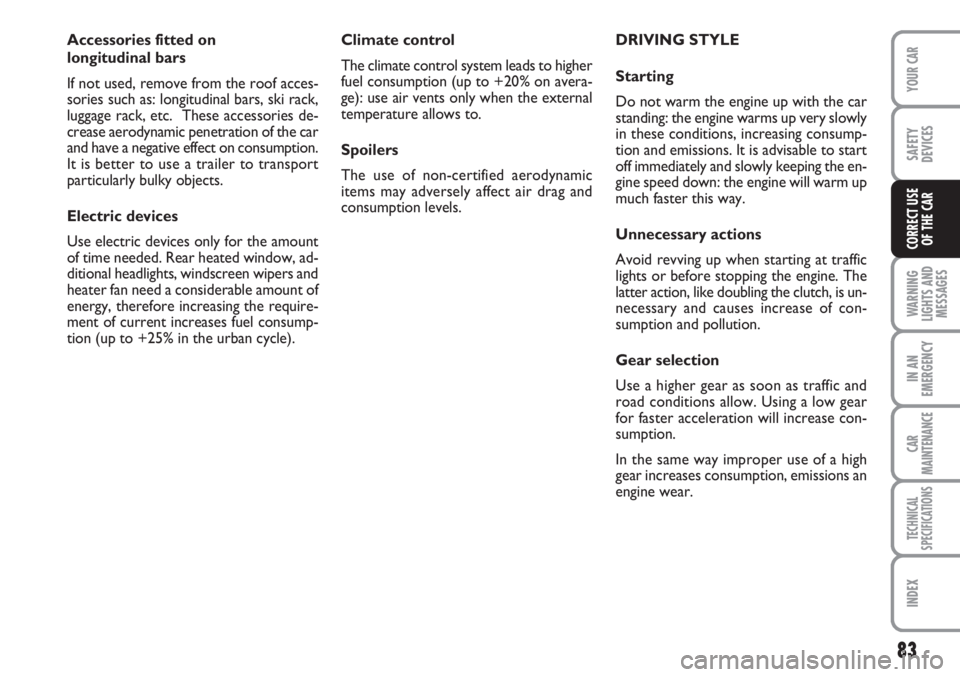
83
WARNING
LIGHTS AND
MESSAGES
IN AN
EMERGENCY
CAR
MAINTENANCE
TECHNICAL
SPECIFICATIONS
INDEX
YOUR CAR
SAFETY
DEVICES
CORRECT USE
OF THE CAR
Accessories fitted on
longitudinal bars
If not used, remove from the roof acces-
sories such as: longitudinal bars, ski rack,
luggage rack, etc. These accessories de-
crease aerodynamic penetration of the car
and have a negative effect on consumption.
It is better to use a trailer to transport
particularly bulky objects.
Electric devices
Use electric devices only for the amount
of time needed. Rear heated window, ad-
ditional headlights, windscreen wipers and
heater fan need a considerable amount of
energy, therefore increasing the require-
ment of current increases fuel consump-
tion (up to +25% in the urban cycle).Climate control
The climate control system leads to higher
fuel consumption (up to +20% on avera-
ge): use air vents only when the external
temperature allows to.
Spoilers
The use of non-certified aerodynamic
items may adversely affect air drag and
consumption levels.DRIVING STYLE
Starting
Do not warm the engine up with the car
standing: the engine warms up very slowly
in these conditions, increasing consump-
tion and emissions. It is advisable to start
off immediately and slowly keeping the en-
gine speed down: the engine will warm up
much faster this way.
Unnecessary actions
Avoid revving up when starting at traffic
lights or before stopping the engine. The
latter action, like doubling the clutch, is un-
necessary and causes increase of con-
sumption and pollution.
Gear selection
Use a higher gear as soon as traffic and
road conditions allow. Using a low gear
for faster acceleration will increase con-
sumption.
In the same way improper use of a high
gear increases consumption, emissions an
engine wear.
Page 87 of 170
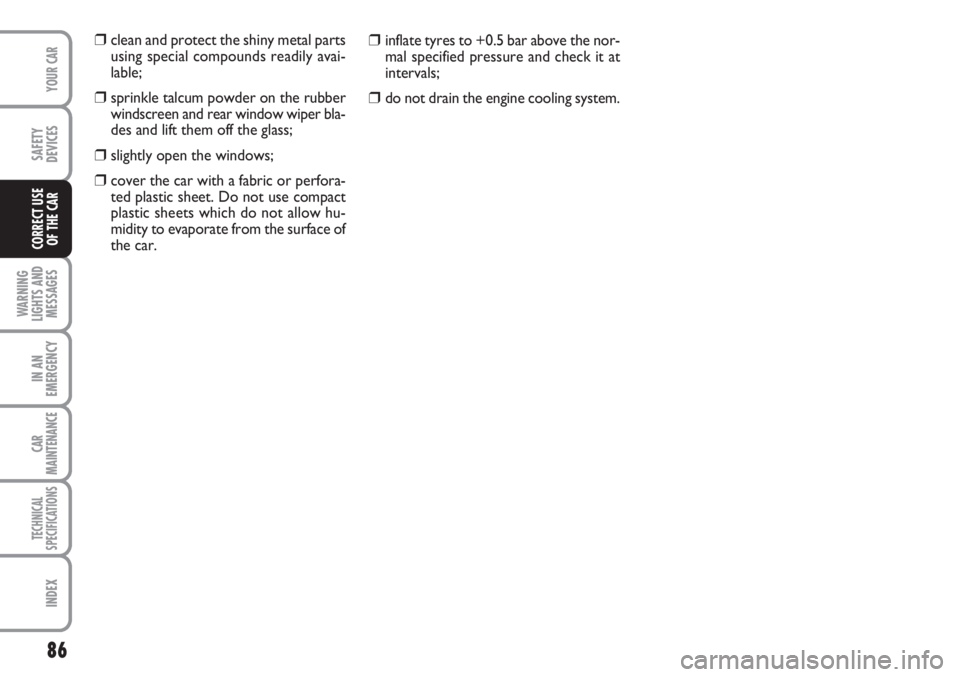
86
WARNING
LIGHTS AND
MESSAGES
IN AN
EMERGENCY
CAR
MAINTENANCE
TECHNICAL
SPECIFICATIONS
INDEX
YOUR CAR
SAFETY
DEVICES
CORRECT USE
OF THE CAR
❒inflate tyres to +0.5 bar above the nor-
mal specified pressure and check it at
intervals;
❒do not drain the engine cooling system.
❒clean and protect the shiny metal parts
using special compounds readily avai-
lable;
❒sprinkle talcum powder on the rubber
windscreen and rear window wiper bla-
des and lift them off the glass;
❒slightly open the windows;
❒cover the car with a fabric or perfora-
ted plastic sheet. Do not use compact
plastic sheets which do not allow hu-
midity to evaporate from the surface of
the car.
Page 120 of 170
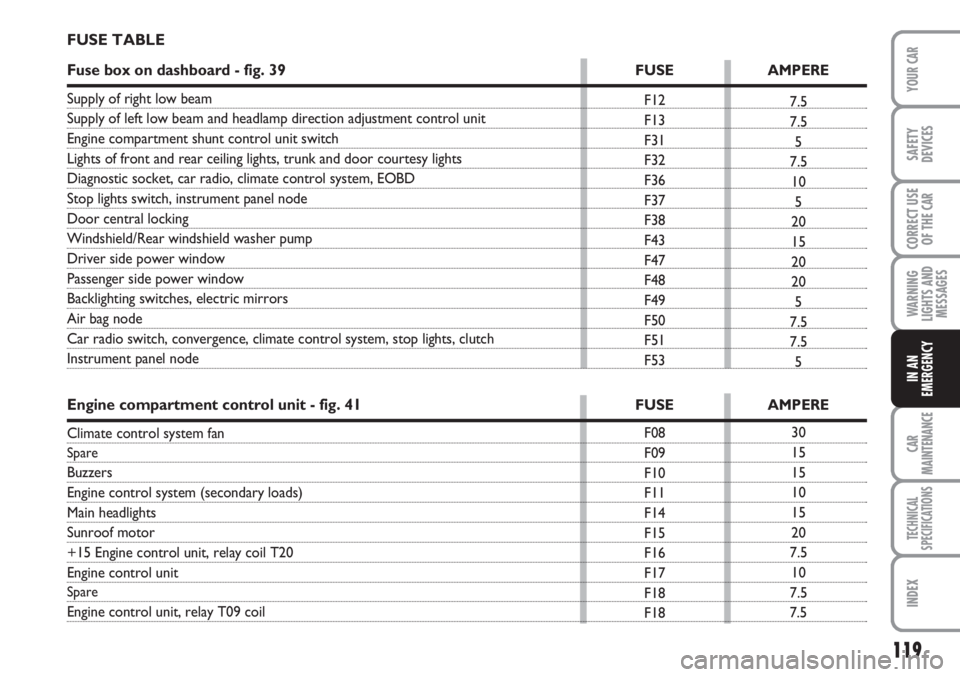
119
WARNING
LIGHTS AND
MESSAGES
CAR
MAINTENANCE
TECHNICAL
SPECIFICATIONS
INDEX
YOUR CAR
SAFETY
DEVICES
CORRECT USE
OF THE
CAR
IN AN
EMERGENCY
F12
F13
F31
F32
F36
F37
F38
F43
F47
F48
F49
F50
F51
F537.5
7.5
5
7.5
10
5
20
15
20
20
5
7.5
7.5
5
F08
F09
F10
F11
F14
F15
F16
F17
F18
F1830
15
15
10
15
20
7.5
10
7.5
7.5
FUSE TABLE
Fuse box on dashboard - fig. 39FUSE AMPERE
Supply of right low beam
Supply of left low beam and headlamp direction adjustment control unit
Engine compartment shunt control unit switch
Lights of front and rear ceiling lights, trunk and door courtesy lights
Diagnostic socket, car radio, climate control system, EOBD
Stop lights switch, instrument panel node
Door central locking
Windshield/Rear windshield washer pump
Driver side power window
Passenger side power window
Backlighting switches, electric mirrors
Air bag node
Car radio switch, convergence, climate control system, stop lights, clutch
Instrument panel node
Engine compartment control unit - fig. 41FUSE AMPERE
Climate control system fan
Spare
Buzzers
Engine control system (secondary loads)
Main headlights
Sunroof motor
+15 Engine control unit, relay coil T20
Engine control unit
Spare
Engine control unit, relay T09 coil
Page 121 of 170
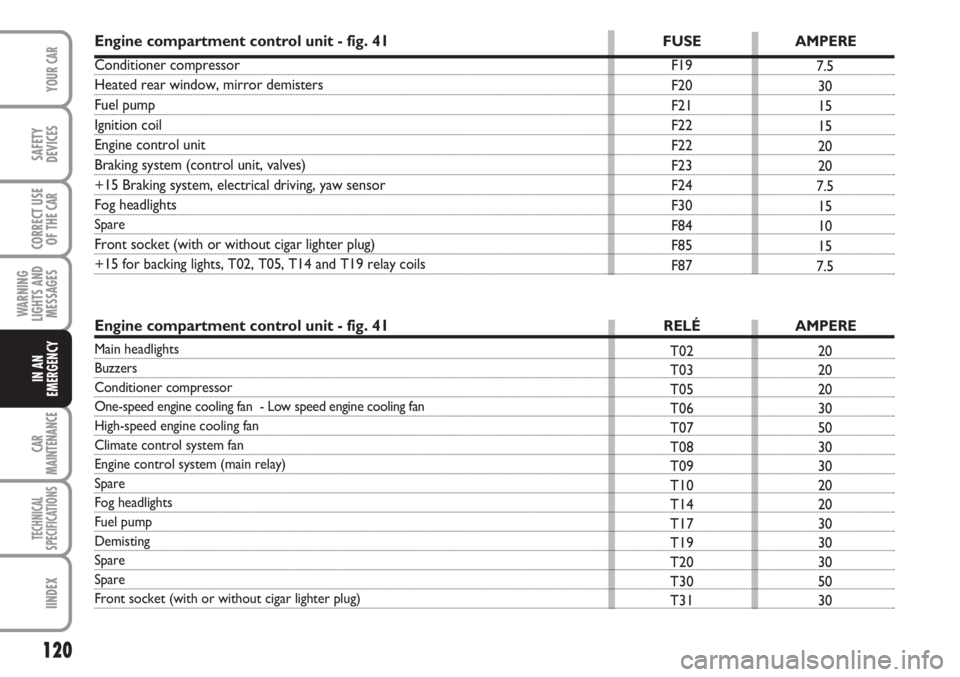
120
WARNING
LIGHTS AND
MESSAGES
CAR
MAINTENANCE
TECHNICAL
SPECIFICATIONS
IINDEX
YOUR CAR
SAFETY
DEVICES
CORRECT USE
OF THE
CAR
IN AN
EMERGENCY
20
20
20
30
50
30
30
20
20
30
30
30
50
30 T02
T03
T05
T06
T07
T08
T09
T10
T14
T17
T19
T20
T30
T31F19
F20
F21
F22
F22
F23
F24
F30
F84
F85
F877.5
30
15
15
20
20
7.5
15
10
15
7.5
Engine compartment control unit - fig. 41FUSE AMPERE
Conditioner compressor
Heated rear window, mirror demisters
Fuel pump
Ignition coil
Engine control unit
Braking system (control unit, valves)
+15 Braking system, electrical driving, yaw sensor
Fog headlights
Spare
Front socket (with or without cigar lighter plug)
+15 for backing lights, T02, T05, T14 and T19 relay coils
Engine compartment control unit - fig. 41RELÉ AMPERE
Main headlights
Buzzers
Conditioner compressor
One-speed engine cooling fan - Low speed engine cooling fan
High-speed engine cooling fan
Climate control system fan
Engine control system (main relay)
Spare
Fog headlights
Fuel pump
Demisting
Spare
Spare
Front socket (with or without cigar lighter plug)